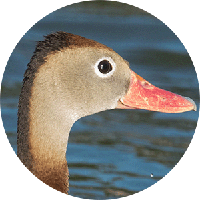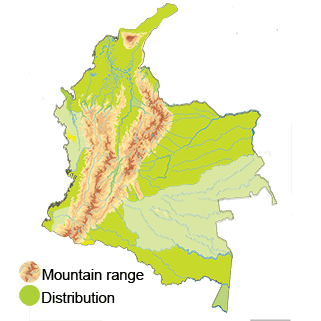Black-bellied Whistling-duck
Appearance: This is a noisy waterfowl that perches in branches of dead trees or on low snags above water. It is widely distributed and can be found up to 2600 m. Its size ranges from 43 to 56 cm (20-22 in). It may weigh up to 1 kg. No sexual dimorphism. Its beak is orange-reddish and legs with a pink coloration. Brown plumage on upperparts and underparts black. Gray color in both sides of head. Black wings with a characteristic white spot that makes them easy to recognize.
Habitat: It feeds day or night on snails, seeds, emerging plants, and invertebrates; and, can be a pest in rice fields. They are found in flocks.
Breeding: They mate for life. They build their cup-shaped nests from woven of dry grass and weeds in dead tree cavities close to ground or water. The nests may hold up to 15 eggs but they also are known to have ‘colony nests’ in which different females may lay up to 60 eggs. Both male and female incubate the eggs for up to 30 days. Fledging occurs at approximately 2 months. They are known to sleep high in trees.
Conservation: In severe decline due to pesticides and habit of nesting in rice field where they are treated as a pest.
Taxonomy
- Kingdom: Animalia
- Phylum: Chordata
- Class: Aves
- Order: Anseriformes
- Family: Anatidae
- Subfamily: Dendrocygninae
- Genus: Dendrocygna
- Species: autumnalis
Importance:
- Ecological Balance: The Black-bellied Whistling Duck plays a role in maintaining the ecological balance of wetland ecosystems. They feed on various aquatic plants, seeds, insects, and small invertebrates, helping control population levels and contributing to nutrient cycling.
- Indicator Species: These ducks are considered an indicator species, meaning their presence or absence can indicate the health of wetland habitats. Monitoring their populations can provide insights into the overall condition and conservation status of wetland ecosystems.
- Biodiversity: The Black-bellied Whistling Duck adds to the biodiversity of the areas it inhabits. Its vibrant plumage and unique behaviors make it a valuable component of avian diversity, enriching the natural beauty of wetland environments.
- Recreational Value: The presence of Black-bellied Whistling Ducks adds to the recreational value of wetlands. Birdwatchers and nature enthusiasts enjoy observing and studying these fascinating ducks, contributing to ecotourism and local economies.
- Conservation Efforts: The conservation of Black-bellied Whistling Ducks contributes to broader wetland conservation initiatives. Protecting their habitats and ensuring their populations thrive helps preserve the overall health and functionality of wetland ecosystems, benefiting numerous other plants and animals that rely on these habitats.
Vocalization
The Black-bellied Whistling Duck is known for its distinct vocalizations, which are characterized by a series of high-pitched whistling calls. Here are some details about its vocalization and song:
- Whistling Calls: These ducks produce whistling calls that are high-pitched and often described as a series of clear, flute-like notes. The calls are melodic and carry over long distances. The pitch and rhythm of the whistles can vary between individuals.
- Group Calling: Black-bellied Whistling Ducks are social birds that tend to gather in large flocks, especially during migration and in communal roosts. When in groups, they engage in chorus-like vocalizations, creating a cacophony of whistles that serve as a form of communication and coordination among them .
- Courtship Calls: During the breeding season, male Black-bellied Whistling Ducks may produce more elaborate and rhythmic vocalizations as part of their courtship displays. These calls aim to attract females and establish boundaries.
- Alarm Calls: Black-bellied Whistling Ducks have distinct alarm calls that they use to alert others in their flock of possible threats or predators. These calls are usually louder and more urgent, designed to quickly communicate danger to nearby ducks.
Despite their name and vocal behavior, the Black-bellied Whistling Ducks do not have a traditional "song" like some other bird species. Instead, their vocal repertoire primarily consists of the whistling calls mentioned above.
Breeding
Breeding typically occurs during the wet season. Black-bellied Whistling Ducks build their nests in tree cavities, abandoned woodpecker holes, or even on the ground. They lay a clutch of 8-18 eggs, which are incubated by both the male and female for about a month. The ducklings leave the nest shortly after hatching and are precocial, meaning they can walk and swim shortly after birth.



















